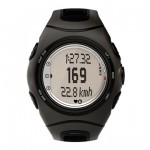 The t6 is Suunto’s premier training heart rate monitor and has been on the market for several years. Thanks to its compact size, the t6 doesn’t even look all that different from a basic sports watch compared to most bulky heart rate monitors, but when paired with its heart rate strap, it becomes a valuable training tool.
The t6 is Suunto’s premier training heart rate monitor and has been on the market for several years. Thanks to its compact size, the t6 doesn’t even look all that different from a basic sports watch compared to most bulky heart rate monitors, but when paired with its heart rate strap, it becomes a valuable training tool.- The heart rate strap is comfortable, easy to put on and off, and provides a reliable, accurate heart rate measurement.
- The t6 has a chronograph option with lap and split functions. It is important to have the basics and the t6 has that covered.
- A barometric altimeter is essential for a watch used in the mountains. It is useful for navigation (probably more so than a compass) and helps keep morale up on long climbs. The t6’s altimeter can be corrected whenever you reach a known altitude so even if changing weather is causing problems, when you reach a know altitude on the map, reset your reference on the watch and it is all set to go. I find that even going weeks at a time without resetting the reference, it is still accurate within +/- 50 meters.
- You can cycle through three screens with fully customizable data fields on each screen. I have one set up for time, one set up with the data I want when I am doing a running workout (Time, HR, Chrono, Lap Time) and one set up with data for skimo races and traverses (Time, HR, Chrono, Altitude, Vertical Ascent). I particularly like this feature as I want to have the exact necessary information on hand and not have to cycle through calories burned or any other bits of useless information.
Uploading the data to a Mac or PC is easy with the attached usb cable that just clips to the face of the watch. Depending on what type of data you record (GPS vs. Non-GPS), the watch can hold more or fewer workouts. I usually upload after one or two workouts and generally don’t have a problem with running out of memory. If you record more than 20-25 hours without uploading, it is possible to run out of space. Several times I have forgotten to clear out the memory and had this happen. Luckily the watch continues to function, it just does not record.
After uploading, you are connected to the Suunto Movescount website where the data is deposited. The software does not have as much functionality as the former Training Software but still allows a good amount of data examination. Files cannot be edited (as far as I can tell) so if you accidentally leave your watch running after the workout, you can’t go in and delete the bad data points.
The screenshot at the left is from a fast attempt at the Spearhead, a ski traverse in the coast mountains. The summary at the top has most of the important data and the graph below can be customized to the variable you want to display (set at heart rate for this example).
Movescount seems to be mainly a social media type program, allowing you to share your activities with other users. It does have a few nice tools and a good calendar function to allow tracking of workouts. It is also good for summarizing date over any time period. By using the tag function for each workout, I can sort my activities by any factor – you could tag and then sort activities by the partners you were with, or the equipment you used. I tag each run with which shoes I used and so have a good estimate of how many km each of my runners have seen. In the screenshot below you can see a selection of all the runs I have tagged my Xtalon running shoes. By using tags for my equipment, I get an idea of how much abuse they have seen.
The basic t6 can be added on to with various pods. These are units to measure speed and distance. The bike pod is mounted to your road or mountain bike, the run pod goes on your shoe, and the GPS pod is a hockey puck that needs to be exposed to the sky. See more on the GPS pod below.
Using the heart rate data, the t6 will calculate your respiration rate and your Exercise Post Oxygen Consumption (EPOC), a measure of training stress according to Suunto. I think it is a bit of a stretch to use this data for anything else. There is an overall training score calculated for workouts on a 1 to 5 scale which give you an idea of the workout intensity. Calories are calculated again from HR data. Unfortunately, the t6 uses a different algorithm to calculate calories than the one used by Movescount. This means that the calories burned on the watch is a bit different than shown on Movescount. Not something that bothers me as neither are truly accurate but others might be a bit confused. My solution is to only look at one source, Movescount being the easiest.
Sweat can accumulate on the contact points for the usb cable and around the battery case. This can cause bad uploads and difficulty removing the battery. I try to wipe it down once and a while and scrape away the gunk with a toothpick. The strap is easily cleaned after removing the electric parts.
Overall: This watch is an excellent training tool. It is especially good for running and cross-country skiing where GPS and navigation functions are less important.
Specifications:
- Price: MSRP – $499 (Sales around $399)
- Housing: Plastic
- Wrist strap: Plastic
- Display: Graphical LCD with backlight
- Accuracy at normal temperature: ±15 seconds per month
- Stopwatch:
- Measuring units: 1/10 second
- Measuring capacity: 99 hours, 59 minutes, 59.9 seconds (or less depending on memory)
- Water proof: up to 100 m
- Dimensions:
- Diameter: 48 mm (1.9 inches)
- Height: 14 mm (0.55 inches)
- Weight: 57 g (2.0 ounces)
- Battery:
- Type: 1x CR2032
- Lifetime: approx. 12 – 18 months (depends a lot – I change mine more frequently)

GPS POD: I have used the GPS pod with limited luck. The pod must be exposed directly to the sky, this means attaching it to the top of a pack or strapping it to your arm. I have hard a hard time getting it to remain in position and maintain the signal. The pod uses two AA batteries with an extremely limited battery life (2-4 hours on mine). Data recorded is only distance and speed. The GPS Pod does not record any Lat-Long data so it cannot be used for navigation and a track cannot be uploaded and superimposed on google maps like other models. Having tried it, I no longer use my GPS Pod.
